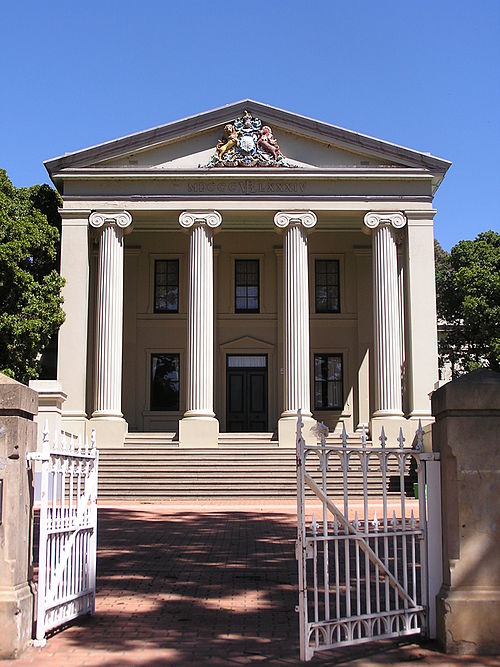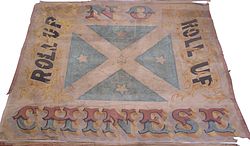Young, New South Wales
Young is a town in New South Wales, Australia. It is the centre of Young Shire. It is on the Olympic Highway. It is about 2 hours drive from Canberra. Young is in a valley surrounded by hills. In 2001 there were 6,821 people living in Young.
| Young New South Wales | |||||||||
|---|---|---|---|---|---|---|---|---|---|
 Young courthouse built in 1884 but transferred to the Department of Education in 1925 and used as the main hall of Young High School | |||||||||
| Coordinates | 34°18′0″S 148°18′0″E / 34.30000°S 148.30000°ECoordinates: 34°18′0″S 148°18′0″E / 34.30000°S 148.30000°E | ||||||||
| Population | 7,170 (2016 census)[1] | ||||||||
| Established | 1826 | ||||||||
| Postcode(s) | 2594 | ||||||||
| Elevation | 439 m (1,440 ft) | ||||||||
| Location | |||||||||
| LGA(s) | Hilltops Council | ||||||||
| State electorate(s) | Cootamundra | ||||||||
| Federal division(s) | Riverina | ||||||||
| |||||||||
Young is known as the Cherry Capital Of Australia and every year hosts the National Cherry Festival.
History

The indigenous people of the district were members of the Burrowmunditory tribe, part of the Wiradjuri people.[2]
James White was the first European settler in the area. He started Burrangong Station (farm) in 1826 by taking an area of 100 square miles.[2]

Gold was found in the area in 1860.[3] Until that time the area was called Lambing Flat. This was an area where sheep were grazed before the gold rush. The town was officially listed in 1861. About 470,000 ounces of gold were sent by the armed gold escort from the goldfields. Up to 20,000 miners were digging for gold including about 2,000 Chinese miners.[2]
From November 1860 through to June 1861 European miners attacked Chinese gold miners in the area. This is now known as the Lambing Flat riots. As gold became harder to find, European miners got upset that the Chinese miners were still finding gold. Many Chinese miners were attacked, robbed and killed. They were chased off the goldfields. Eventually the riots were stopped and the Chinese miners had their mining areas given back. The New South Wales Parliament passed the Chinese Immigration Bill. This put a limit on the number of Chinese that could come to New South Wales on any ship. They also had to pay a tax to come New South Wales.
In 1889 Young was the first country town in Australia to have electricity for the streets and houses. Young was the first Local Government Area to start a country school bus system in New South Wales[2]
Education
There are seven schools in Young:
- Bellhaven Special School
- St Mary's Primary School
- M-E-T School Young Campus
- Young North Primary School
- Young Public School
- Hennessy Catholic College
- Young High School
Sport
- Young Yabbies are a Rugby Union team playing in the Southern Inland Rugby Union competition.
- Young Cherrypickers are a Rugby League team playing in the Group 9 competition
- Young Saints are an Australian Rules Football team playing in the Central West competition.
- Young Lions are a Soccer team playing in the Bathurst District Soccer Senior Mens and Senior Women's competition.
Newspapers
- Burrangong Argus 1864-1914 (became the Young Witness)
- Burrangong Chronicle 1873-1902 (became the Young Chronicle)
- Burrangong Courier 1962
- The Lambing Flat Miner 1862-1961
- Young Chronicle 1902-1947 (incorporated in The Young Witness)
- The Young Witness 1914-
Radio Stations
- 2LF AM 1350 (commercial),
- ROCCY FM FM 93.9 (commercial),
- SBS FM 98.7 (retransmission),
- JJJ 90.7,
- ABC Radio National 89.1/97.1,
- ABC Riverina 89.9/96.3,
- Classic FM 88.3,
- Cherry Capital Music & Sport "2YYY, FM 92.3" (Local Community Broadcasting Radio Station).
The Lambing Flat Chinese Tribute Gardens
Young Shire Council has started these gardens next to Chinaman’s Dam. This is an old railway dam about 4 km south of Young. They are made to create a peaceful feeling like the Japanese garden at Cowra.
Chinaman’s Dam was built in the 1860s by Dutch brothers, Herman and John Tiedeman. They used the water for the sluicing of their Victoria Hill gold claims. In the 1870s, the brothers sold the area, including the dam, to a Chinese group who worked the site. It is in a small gully called Pitstone on Sawpit Gully.
In 1882 the NSW government started to build the first part of the Blayney to Demondrille railway line. To provide water for the steam trains, they decided to use the dam and pump water from it to a tank, known as Young Tank, at the 246 mile post. It is not known whether the railways improved the old dam or built a new one.
From 1885 to 1901, trains stopped at Young Tank to refill with water. In 1901, trains were able to get water at Young Railway Station. The supply of water came from Chinaman’s Dam. The size of the dam was enlarged in 1911 to hold about 2 million gallons.
The dam was a popular spot for swimming.
When the town water supply was connected to the Burrinjuck Dam, the railways stopped using Chinaman’s Dam. In 1937 the area turned into a 36-acre park. The Shire Council looks after the gardens. The dam has since been made bigger.[4]
Young, New South Wales Media
The Roll Up banner around which a mob of about 1,000 men rallied and attacked Chinese miners at Lambing Flat in June 1861. The banner is now on display in the museum at Young.
References
| Wikimedia Commons has media related to Lua error in Module:Commons_link at line 62: attempt to index field 'wikibase' (a nil value).. |
- ↑ Australian Bureau of Statistics (27 June 2017). "Young (Urban Centre)". 2016 Census QuickStats. Retrieved 3 December 2017.
- ↑ 2.0 2.1 2.2 2.3 "History". visityoung.com. Archived from the original on 2007-02-08. Retrieved 2007-02-09.
- ↑ "History of Young". young.nsw.gov.au. 2010. Archived from the original on 30 October 2009. Retrieved 4 October 2011.
- ↑ Chinaman's Dam Young Sharp, Stuart Australian Railway Historical Society Bulletin, January, 2002 pp3-8








